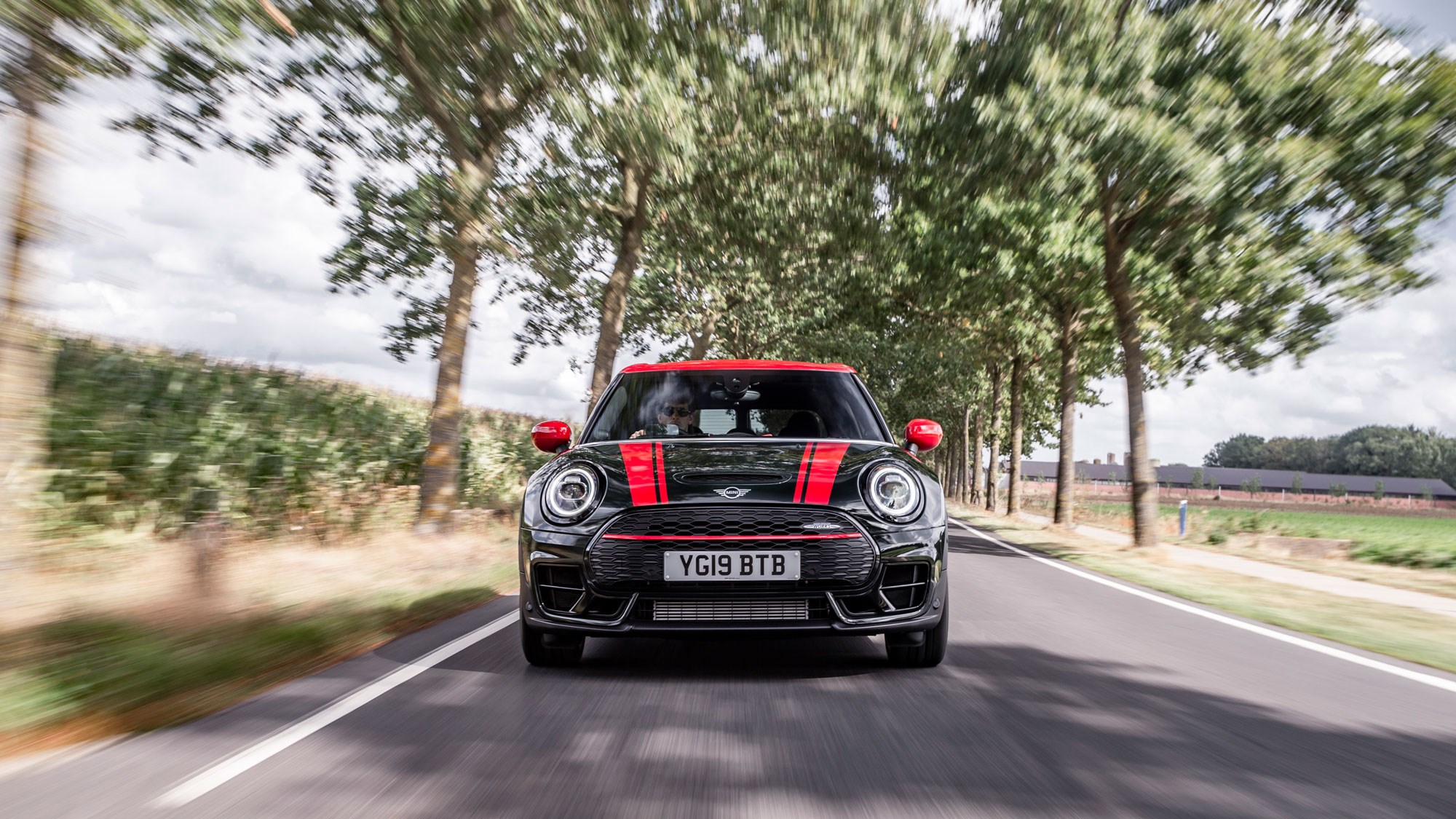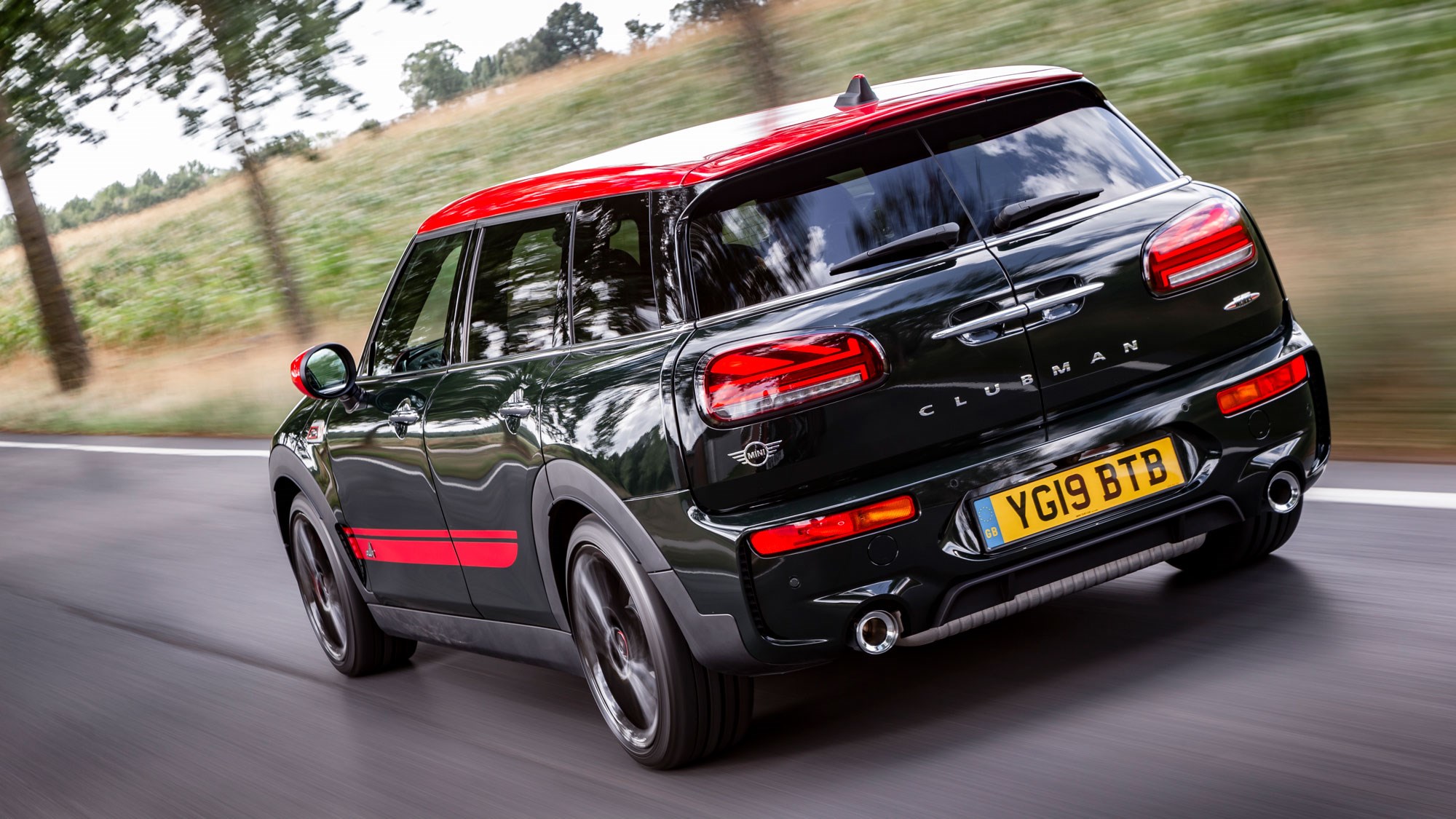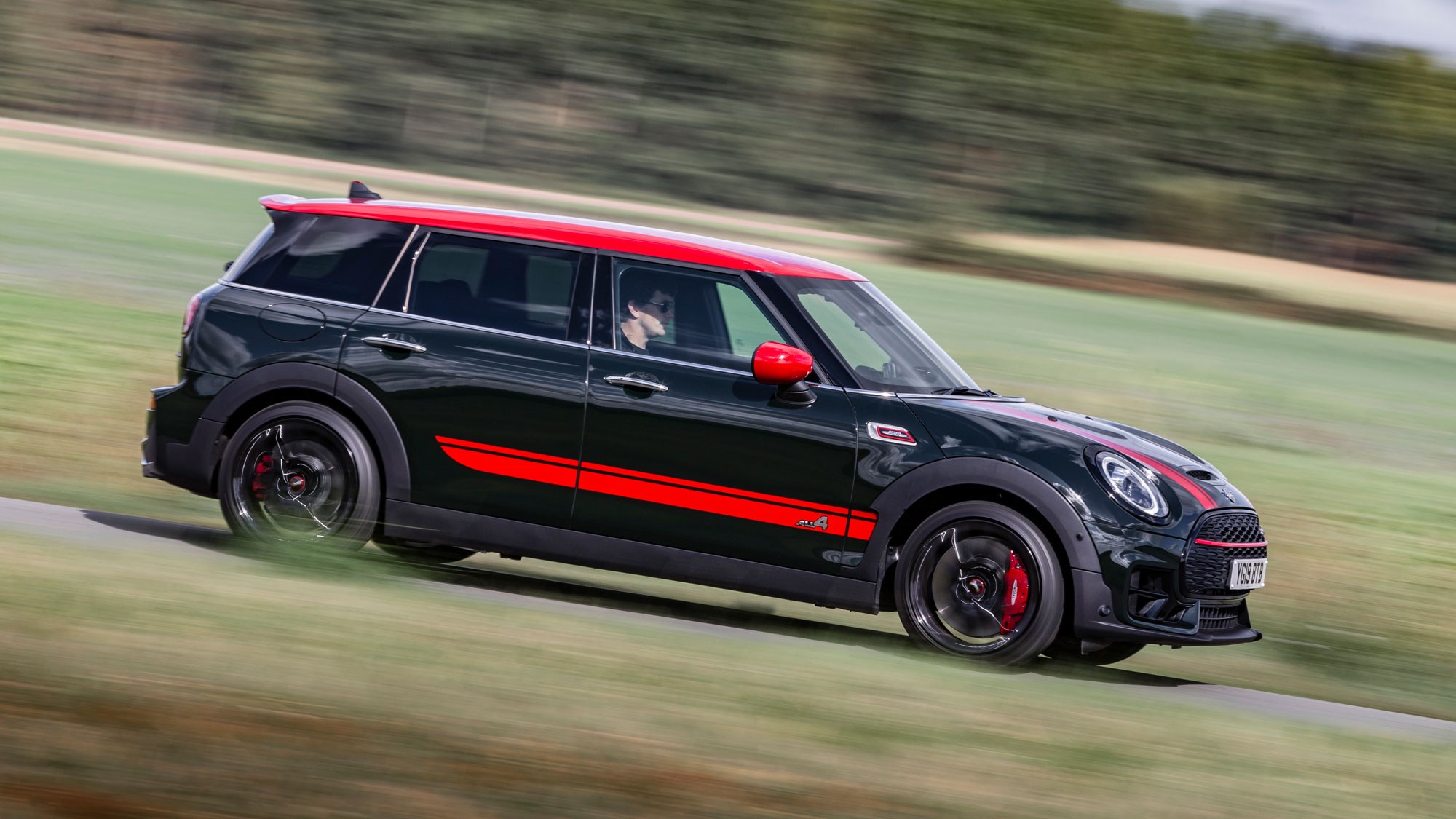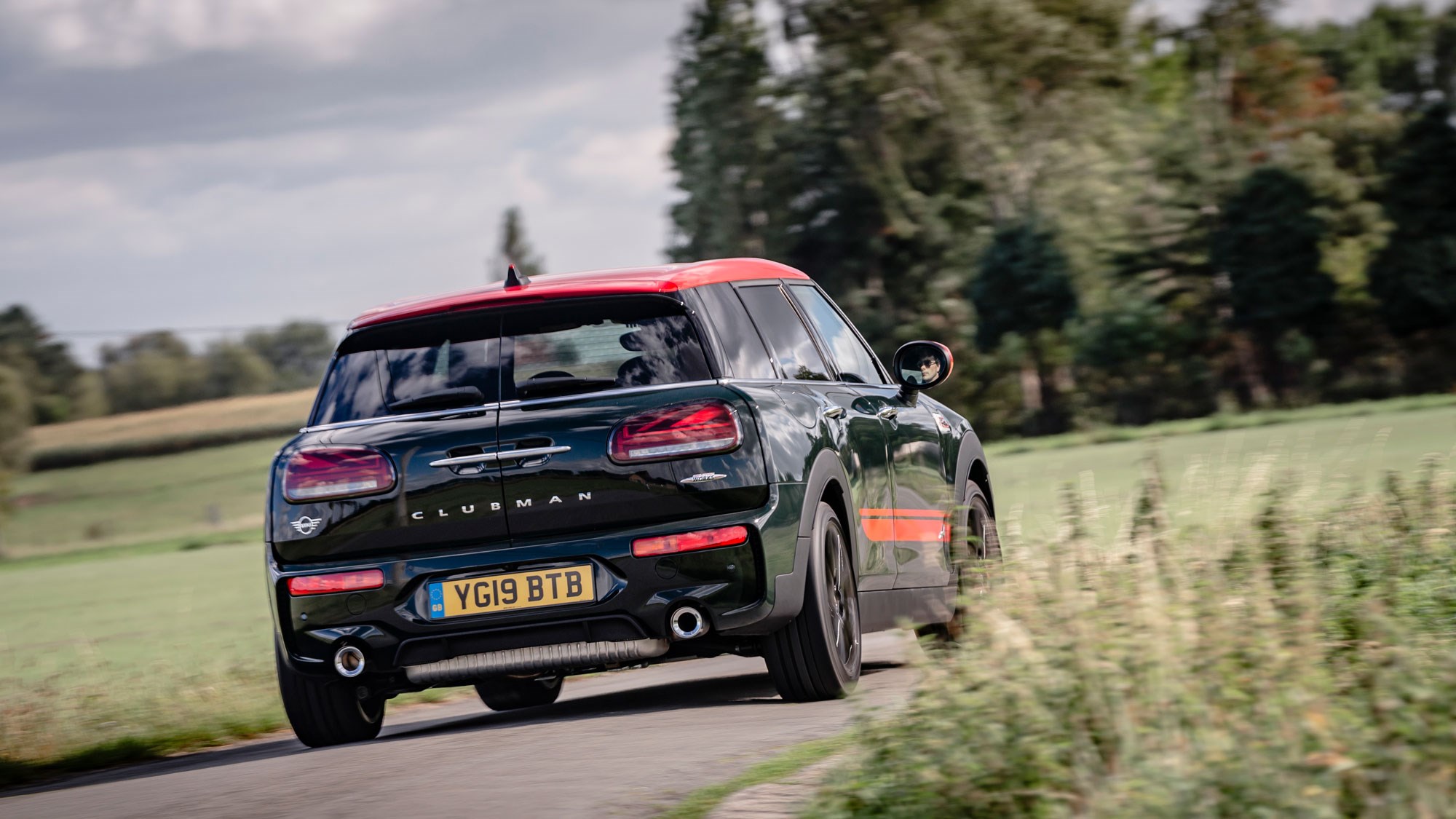► 74bhp power boost
► Celebrates Mini’s 60th birthday
► Consider a Golf R
How to celebrate the innovative front-wheel-drive Mini’s 60thbirthday? By giving the biggest all-wheel drive John Cooper Works derivatives a 74bhp power boost. That’s about as much as the original Mini Cooper S produced in total, and in some ways it is a bit perverse, but it means both the John Cooper Works Countryman crossover and Clubman, erm, estate thing now squeeze 302bhp from turbocharged four-cylinder engines, which we’d say justifies some bunting – and also helps offset the 200kg plus penalty these models carry.
We’re driving the Clubman John Cooper Works, which costs from £34,250 – or about £1600 less than the ubiquitous Golf R.

More details please…
It’s not just a power hike, this is a mid-life facelift for the Clubman, though it’s a pretty conservative one visually: different honeycomb grille, LED fog lamps, new mirrors, alloys, three new colours. And the Brexit rear lights.
It’s the performance side of things that’s more enticing. The TwinPower Turbo (aka a single twin-scroll turbo) engine gets a revised crankshaft, new vibration damper, new intercooler and calibration tweaks. The resulting 302bhp and 332lb ft (up 74lb ft) squirts the Mini from nought to 62mph in 4.9 seconds, an impressive 1.4sec up on the previous JCW, and a match for that Golf.
All-wheel drive and a new Steptronic eight-speed auto transmission is your only option, and is combined as standard with a limited-slip diff on the front axle. The braking system is uprated, with four-piston calipers all-round (previously the rear axle got sliding calipers) that grip 360mm brake discs up front, 330mm versions at the rear.
How about the chassis?
The MacPherson strut front/multi-link rear suspension can be specified in a few different ways: adaptive dampers are optional, and you can lower both the standard chassis and adaptive chassis by 10mm at extra cost. Unusually, only 18-inch alloys are available with adaptive dampers. Optional 19s come purely with passive dampers, the logic being that the ride quality is too poor on 19s when the adaptive dampers are in their firmest setting. Fair enough. But conversely the ride would presumably have been smoother in the softest setting. We’re driving on the most basic 18s/passive dampers/standard ride height spec.

How does the Clubman JCW drive?
It’s good fun, if lacking the real sparkle of (admittedly slightly differently shaped) hot hatches like the VW Golf R/ Renaultsport Megane/Hyundai i30N Fastback.
The engine is impressive, offering notably crisp throttle response for a turbo engine, a real eagerness to haul from very low revs with minimal lag, and a bassy, burbly soundtrack that adds a richness to this four pot’s urgency. Wind it out through the gears and there’s certainly plenty of performance, though it’s quick rather than truly rapid and it’s at its perkiest and most satisfying in the mid-range. The brakes have a similarly punchy feel: very little slack to push through before the pedal bites, and strong stopping power thereafter.
Shame the eight-speed auto feels a little lazy, even in its Sport setting – it’s nicely mapped, but generally there’s a small delay between the shifts until you use all the power and the revs. At this point the delay is replaced by a torque impulse that’s more unwelcome kick in the back than crisp little snap.
Does it still handle like a go-kart?
There is some of the Mini hatch’s energy here, but there’s no mistaking the Clubman feels a larger, longer, heavier car, as you’d expect – it’s got over 200kg and almost 40cm up on the Mini JCW hatch (but the Clubman does have a better power-to-weight ratio thanks to the 74bhp boost).
The steering takes a second to wake up around the dead-ahead and there’s a little body roll to gather up, which blunts some of a Mini’s responsive turn-in. It’s possible the optional 10mm lower chassis would help initial steering response by tightening up that body movement. That said, the Clubman does have quite a busy, firm ride. It’s perfectly tolerable on most main roads, but a B-road excursion revealed an excess of patter and lack of wheel control.

There’s still a sense of fun to the handling, though: lift the throttle mid roundabout and the rear end will slide benignly and satisfyingly, and the all-wheel drive and grippy Michelin Pilot Super Sports let you plant the throttle and power away without a hint of wheel scrabble. So there’s certainly an interactivity to tap in to here, even if the Clubman’s responses are more languid and less incisive than the shorter, more reactive hatchback models.
What’s it like inside?
It’s a grown-up feel, if little different from the pre-facelift model. There’s still some Mini funkiness (big round infotainment screen in the centre of the dash where the speedo once lived in the original; toggle switches; that kind of thing), but this is a mature cabin that feels well put together, if a little on the austere side finished in black.
The seats are lovely, though, with a little leather on the bolsters but more in the way of fabric and Alcantara: they’re positioned reasonably low, have a nice squish of comfort and hold you well too. Standard equipment includes sat-nav with real-time traffic information, heated seats, reversing camera and parking sensors.
There’s also plenty of room for four six footers in here thanks to the 2670mm wheelbase, and a reasonable if by no means huge boot: 360 litres compares with 343 for the Golf R. The unusual double rear doors do block the driver’s vision of following traffic, though – similar technology to Land Rover’s ClearSight rear-view mirror would be a bonus here.

Verdict
The energetic 302bhp engine is the star of the revised Clubman John Cooper Works, but it’s saddled with a body that’s not as attractive as similarly powerful hot hatches and a chassis that can’t strike the same balance of driving excitement and comfort as a Golf R. You’d need to really want that quirky body and ample second-row space to go for a Clubman JCW. You can’t get a Mini hatchback with all-wheel drive or the punchier engine, but it’d still be our pick of the JCW range.